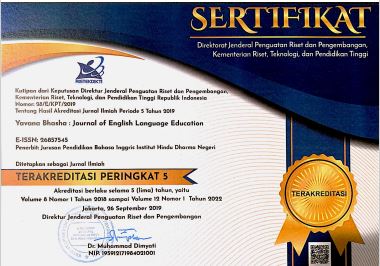Kinesics in EFL Language Teaching
DOI:
https://doi.org/10.25078/yb.v3i2.2120Keywords:
EFL, gesture, kinesics, teachingAbstract
This study was descriptive qualitative research to reveal the use of kinesics in EFL
classrooms in STAHN Mpu Kuturan Singaraja. Specifically, the purposes of this study
were: 1) to describe of how English lecturers perceive the kinesics in EFL communication;
2) to describe kinds of kinesics that the English lecturers use in their EFL classrooms; 3) to
describe how the kinesics takes place in the EFL teaching and learning activities. The
informants of the present study were three English lecturers in which the first informant
was as the main informant and the two other informants were the secondary informants.
The data were gathered through interviews using a validated interview guide. Data
analysis was done by using Interactive Data Analysis Model proposed by Miles &
Huberman (1984). From the data analysis conducted, this present study found out that
kinesics was always be found in the communication process in EFL teaching and learning
activities as it was very beneficial to help the students in acquiring the target language.
There were four types of kinesics dealing with the EFL teaching and learning process
found. Those were gestures, head movements, eye contact, and facial expressions. Those
basic aspects of kinesics are very useful and considered as an easier way to help the EFL
students to understand the meaning of utterances containing some difficult vocabularies
as well helped them to acquire the target language







